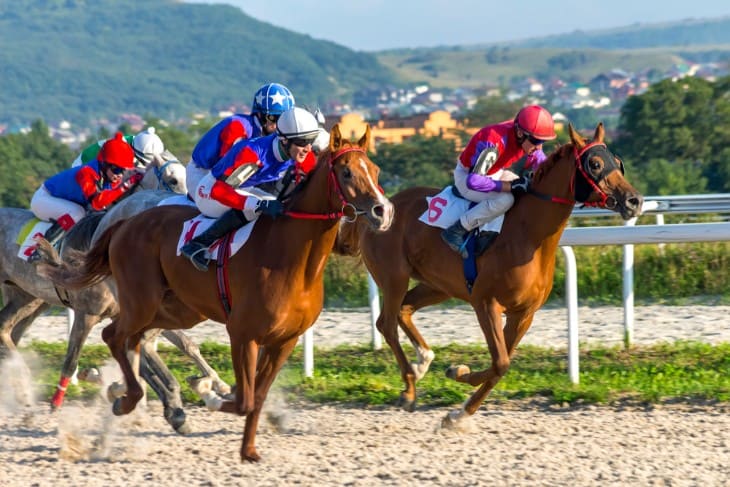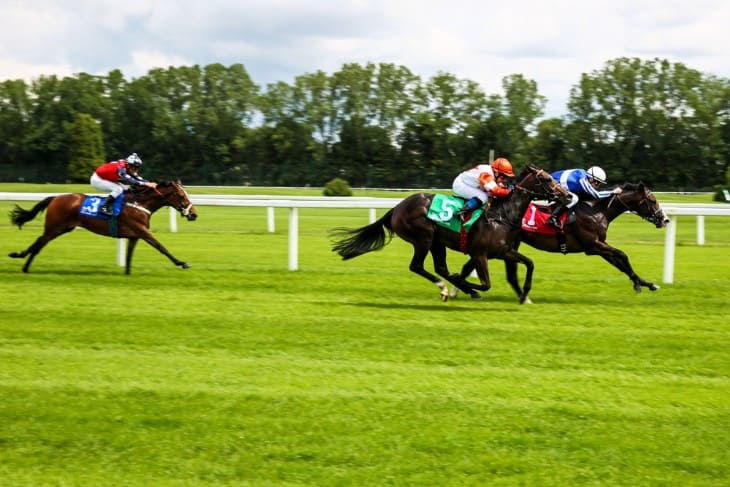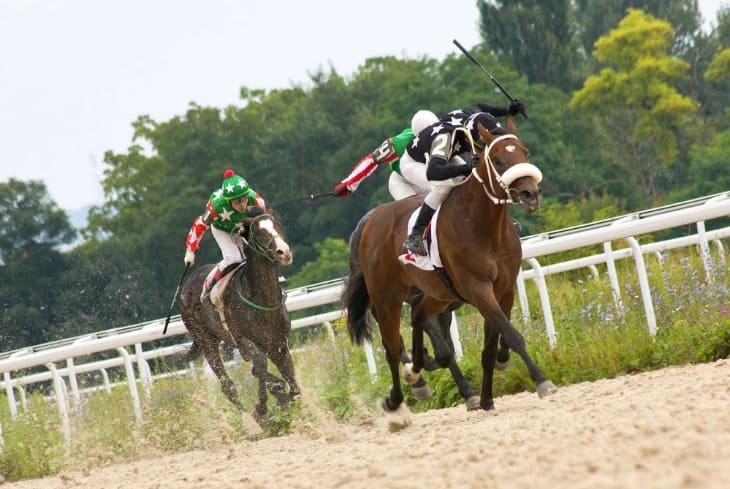- Each-Way Betting in Grand National: Strategic Approaches
- Comparing Fixed Odds and Tote Betting in Horse Racing
- Key Factors Influencing Each-Way Betting Decisions
- The Role of Bookmakers in Each-Way Betting
- Analysing Past Winners: Trends and Patterns in the Grand National
- The Impact of Horse and Jockey Partnership on Betting Outcomes
- Risk Management: Balancing Stakes and Returns in Each-Way Betting
- Successful Each-Way Bets in Grand National History
- Conclusion
Each-way betting is a popular form of wagering, particularly in horse racing events like the Grand National. This type of bet is essentially a two-part wager, comprising a 'win' bet and a 'place' bet. The 'win' component is straightforward – the bettor predicts a horse to win the race outright. The 'place' part, however, is slightly more complex. It pays out if the selected horse finishes in one of the predetermined top positions – often the first three or four, depending on the bookmaker's rules and the number of runners in the race. The attractiveness of each-way betting lies in this dual nature, offering a balance between the higher risk of a win bet and the lower risk of a place bet.
The payout for each part of the each-way bet is calculated differently. If the horse wins the race, both the win and place bets pay out. The win bet is paid at the odds agreed when the bet was placed. The place part is paid at a fraction of these odds, typically a quarter or a fifth. However, if the horse only places and doesn't win, only the place bet pays, and the win bet is lost. This mechanism makes each-way betting a popular choice among those who seek a more cautious approach, hedging against the risk of their horse not finishing first.
The Grand National, held at Aintree Racecourse near Liverpool, is one of the most famous horse races globally. Established in 1839, it has become a British sporting institution, renowned for its challenging course. The race features larger-than-life fences like Becher's Brook, The Chair, and the Canal Turn, which have become infamous for their difficulty and the excitement they bring to the event. The Grand National is a steeplechase, a type of horse race where competitors must jump over various obstacles. It's known for its length – over 4 miles and 514 yards – and the endurance and agility it demands from both horse and jockey.
Over the years, the Grand National has seen a wide array of winners, from unlikely underdogs to seasoned favourites. Its history is peppered with dramatic moments and tales of extraordinary feats. One of the most notable winners is Red Rum, trained by Ginger McCain, who won the race three times in the 1970s, becoming a legend in the process. The Grand National has not only been a sporting event but has also significantly influenced each-way betting practices. Its unpredictable nature and the large field of runners make it an ideal event for each-way betting, as picking an outright winner is often more challenging than in other races.
Each-Way Betting in Grand National: Strategic Approaches
When engaging in Each-Way Betting for the Grand National, strategic considerations are paramount. Bettors often employ various tactics to maximise their chances of a return. One common strategy is to focus on horses that have a consistent track record of finishing in the top positions, even if they aren't the outright favourites. This approach recognises the value in a horse's ability to place, which is critical in each-way betting. Another tactic is to consider the impact of external factors such as ground conditions, weather, and the horse's performance in recent races. Horses that perform well in similar conditions to those expected on the day of the Grand National can be smart each-way bets.
Another strategic aspect involves the selection of bookmakers and the odds they offer. Experienced bettors often shop around for the best terms on the place part of the bet, seeking out bookmakers who offer more favourable place terms, such as paying out on the first five places rather than the first four. This strategy increases the chances of a return on the place part of the bet. Additionally, many punters pay close attention to the number of runners in the race, as this can affect the place terms offered by bookmakers. Races with more runners typically offer better place terms, making each-way bets more attractive.
Comparing Fixed Odds and Tote Betting in Horse Racing
When it comes to horse race betting, two main types of wagers are prominent: fixed odds betting and tote betting. Both have their unique features and appeal to different types of bettors.
- Fixed Odds Betting: In fixed odds betting, the bettor knows the odds at the time of placing the bet. These odds are determined by the bookmaker and remain fixed, regardless of any subsequent changes in the betting market. The advantage of this type of betting is the certainty it provides; bettors know exactly how much they stand to win if their horse is successful. However, the odds may not always represent the true chances of a horse winning or placing, as they are influenced by the bookmaker's need to balance their book.
- Tote Betting: Tote betting, also known as pool betting, differs significantly. Here, all bets of a particular type (e.g., win, place, each-way) are accumulated into a pool. The payout odds are determined by the size of the pool and the number of winning tickets. This form of betting can sometimes offer better value, especially in races with a large field like the Grand National. The final odds are not known until the pool closes at the start of the race. Tote betting can yield higher payouts for less fancied horses, as the odds are influenced by the betting behaviour of the general public rather than the predictions of professional oddsmakers.
Key Factors Influencing Each-Way Betting Decisions
When punters consider Each-Way Betting, several key factors significantly influence their betting decisions. The first and perhaps most critical factor is the form of the horse. Bettors meticulously examine a horse's past performances, especially in races similar to the Grand National in terms of distance and difficulty. A horse that has consistently performed well in long-distance races or challenging courses is often considered a strong candidate for each-way betting. Another factor is the jockey's experience and track record. A skilled jockey with experience in navigating the arduous Aintree course can greatly enhance a horse's chances of finishing in a top position.
The second vital factor is the betting odds. Odds not only reflect a horse's perceived chances of winning or placing but also determine the potential payout of an each-way bet. Bettors often seek horses with slightly longer odds, as these can offer a more favourable balance between risk and reward. While favourites tend to have shorter odds and a higher probability of winning, they often offer less value in terms of payouts, especially for the place part of an each-way bet. Conversely, a horse with longer odds that still has a reasonable chance of placing can offer a more lucrative return for the place portion.

The Role of Bookmakers in Each-Way Betting
Bookmakers play a crucial role in the realm of Each-Way Betting, particularly in high-profile races like the Grand National. They are responsible for setting the odds for each horse, which are initially determined by the bookmakers' assessments of each horse's chances of winning or placing. These odds can fluctuate based on various factors, including the amount of money wagered on each horse and changes in conditions or horse form leading up to the race. Bookmakers also set the terms for each-way bets, such as the fraction of the win odds paid for a place and the number of places paid.
The competitiveness of the market compels bookmakers to offer attractive terms and promotions to lure punters, especially during big events like the Grand National. Some bookmakers offer enhanced place terms, such as paying out on the first five or six places instead of the standard four. Others may offer special promotions like money-back specials or enhanced odds for certain horses. These offerings can significantly impact betting strategies, as punters seek to maximise their potential returns and minimise risks. The savvy bettor will often compare the offerings of various bookmakers before placing their each-way bets, seeking the most favourable terms and the best value for their wagers.
Analysing Past Winners: Trends and Patterns in the Grand National
In the context of Each-Way Betting, analysing the trends and patterns exhibited by past winners of the Grand National can provide valuable insights. Historical data often reveal certain traits that are common among successful horses in this challenging race. When evaluating past winners, several factors stand out:
- Age and Experience: Typically, horses aged between 8 and 11 years have a better track record in the Grand National. This age range often indicates a blend of maturity, stamina, and experience, crucial for the demanding nature of the race.
- Weight Carried: The weight a horse carries is another significant factor. Historically, horses carrying a weight of less than 11-00 have performed better. This trend can influence betting decisions, as horses carrying less weight may have a higher chance of finishing in the top positions.
- Previous Course Experience: Horses that have previously raced at Aintree, particularly those who have performed well over the fences, often have a competitive edge. Familiarity with the course can be a significant advantage in a race as unique as the Grand National.
- Form: The current form of the horse, especially in races leading up to the Grand National, is a critical indicator. Horses that have shown good form in other steeplechases or have a consistent performance record are often favoured in each-way betting.
The Impact of Horse and Jockey Partnership on Betting Outcomes
The partnership between the horse and the jockey is a pivotal aspect in the world of horse racing and significantly influences Each-Way Betting decisions. A strong and understanding relationship between the two can greatly enhance performance, particularly in a race as demanding as the Grand National. Jockeys with experience and skill in navigating complex courses can make a substantial difference, especially when guiding a less experienced horse. Conversely, a skilled horse with an inexperienced jockey might not perform to its full potential.
This factor becomes even more pronounced in the context of each-way betting. Bettors often look for combinations where both the horse and jockey have proven track records. For instance, a jockey who has successfully completed the Grand National multiple times might be better equipped to handle the pressures and challenges of the race, thus increasing the likelihood of finishing in a top position. Similarly, a horse known for its endurance and jumping ability, paired with a jockey who has experience in managing such traits effectively, can be a compelling choice for each-way bets. This partnership dynamic is always a key consideration for seasoned punters when making their betting selections.

Risk Management: Balancing Stakes and Returns in Each-Way Betting
Effective risk management is essential in Each-Way Betting, especially in unpredictable events like the Grand National. Bettors must balance their stakes and potential returns carefully to ensure a sustainable betting strategy. Key elements to consider in this balancing act include:
- Stake Allocation: Deciding how much to wager on each-way bets is a crucial decision. It's generally advisable to wager a proportion of one's total betting budget, keeping in mind the need to mitigate potential losses.
- Diversification of Bets: Placing bets on multiple horses can spread the risk. Bettors often choose a mix of favourites and outsiders, balancing the potential for high returns with the likelihood of at least some return on their investment.
- Understanding Place Terms: Being aware of the bookmakers' place terms is vital. These terms can vary, especially regarding the number of places paid out and the fraction of the win odds for the place part of the bet.
- Odds Evaluation: Constantly monitoring the odds for potential value is a key part of risk management. Odds that are too short may not offer sufficient value, while very long odds might reflect a very low chance of success.
Successful Each-Way Bets in Grand National History
Examining specific instances of successful Each-Way Betting in the Grand National's history can offer valuable insights. These case studies highlight strategic decisions and factors that contributed to notable each-way betting successes:
- Mon Mome (2009): Mon Mome's victory in 2009 at odds of 100/1 remains one of the most extraordinary upsets in Grand National history. Each-way bettors who backed Mon Mome reaped significant rewards, as even the place part of their bets paid out at 25/1 (a quarter of the win odds). This case underscores the potential value in backing outsiders in each-way bets.
- Amberleigh House (2004): Amberleigh House, trained by Ginger McCain, came from behind to win the 2004 Grand National. Each-way bettors who recognised McCain's previous success with Red Rum and Amberleigh House's solid track record at Aintree could capitalise on favourable place terms, as the horse was not among the top favourites.
- Neptune Collonges (2012): In 2012, Neptune Collonges won in a photo finish, offering a high payout for win bets. However, each-way bettors also benefitted, as the horse was not the outright favourite, thus providing generous place terms.
Conclusion
Looking to the future, Each-Way Betting in the Grand National is likely to remain a popular and strategic choice for punters. The nature of the Grand National, with its unpredictable course and large field of runners, continues to make each-way betting an attractive option. Bettors can manage their risk while still enjoying the potential for significant returns, especially when backing horses with longer odds.
- Each-Way Betting in Grand National: Strategic Approaches
- Comparing Fixed Odds and Tote Betting in Horse Racing
- Key Factors Influencing Each-Way Betting Decisions
- The Role of Bookmakers in Each-Way Betting
- Analysing Past Winners: Trends and Patterns in the Grand National
- The Impact of Horse and Jockey Partnership on Betting Outcomes
- Risk Management: Balancing Stakes and Returns in Each-Way Betting
- Successful Each-Way Bets in Grand National History
- Conclusion






